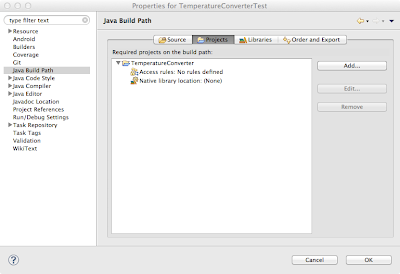Q:I followed your example. I set up the test project in a similar way.
But try to write a TestCase for the utility class from the original
project.
Eclipse says "Class under test does not exist in the current project."
It's kind of reasonable to me, since that class is indeed in another
project.
I only have experienced using JUnit to test normal Java Project where
the test directory is inside the project.
Also, I checked out the two example projects and found there is a
build.properties and build.xml. Is that the reason that you can import
the original class:
"import com.example.i2at.tc.TemperatureConverter;"?
Thanks
Best wishes,
Ryan
Posted by Ryan Huang.
A:If you have imported both projects (main & test) into Eclipse you should have no problems because the versions available at github have the required properties set.
However, if for some reason they were not set properly, this is what you should verify in your test project's Java Build Path -> Libraries
The other files you mentioned are used when you build with ant.
